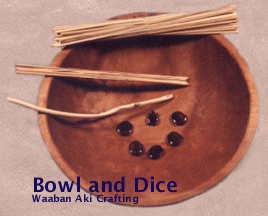
Image adapted from "Games of the North American Indian", Culin:1975
Bowl & Dice Game
| The dice game has innumerable variations across North America. This traditional game is called Hubbub in southern New England. The game described in the 1600s includes five or six small dice which are tossed in a wooden bowl or basket. The game is accompanied by sticks or beans for scoring. Dice were usually carved from bone or antler, in some versions plum or peach pits were used. Dice were engraved, burned and polished or painted to distinguish one side from the other when they are tossed. |

Image adapted from "Games of the North American Indian", Culin:1975 |

Game image compliments of Waaban Aki Crafting | The dice game was often played in a large gaming house or arbor made from poles set in the ground and covered with tree boughs. Natives of New England played this game in the 1600s for great stakes. Animal skins and furs, kettles, knives, axes were set out and huge stores of strung wampum were hung from the arbor poles. |
Elements of reciprocal exchange is demonstrated in traditional gaming of Native Americans in southern New England. Money in this dice game was gambled away, but was probably won back again, in subsequent games. The dice game provoked great celebration and shouthing… with cheering 'hub hub hub'… hence the name hubbub for the game. Entire villages sometimes wagered against other villages over the two individuals chosen to play the game.
The object of the game is to acquire
as many sticks as possible and then bankrupt your opponent. Play
takes place in three phases. In the first phase players try to
accumulate as many sticks as possible in a primary pile. In the
second phase (known as drifting) players attempt to move as many
pieces to a second pile (known as the treasure pile). Sticks
in the treasure pile have increased value against sticks in the
opponent's pile. The third and final phase of the game occurs
when one player has sufficient markers in the second pile to bankrupt
the opponent. During the course of play, markers are awarded
when a "roll" of five or six of the dice come up as
the same color (either brown or white). Players alternate casting
the dice or lightly banging the bottom of the bowl. This version of
the game requires 6 dice, 56 Narrow Sticks, 4 Flat Sticks, and 1
Crooked Stick (Speck 1976).
Beginning the game (First Phase)
Drifting (Second Phase)
Ending the Game: Paying Up (Third Phase)
When one player has a big treasure (second) pile and believes they can bankrupt the opponent the game enters the final phase. When this happens you challenge the opponent to pay up according to the values mentioned above and in the following tables. If the opponent pays up all their markers but is in possession of the crooked stick they get three final throws. If these last throws are either all 5 alike or 6 alike the opponent wins.
First Phase
| Roll | First roll | Second roll | Third roll |
| 5 Alike | 3 Narrow sticks | 9 Narrow sticks | 1 Flat sticks |
| 6 Alike | 1 Flat stick | 2 Flat sticks | 3 Flat sticks |
Second Phase (Drifting)
| Roll | First roll | Second roll | Third roll |
| 5 Alike | 1 Narrow sticks | 3 Narrow sticks | 1 Governor stick |
| 6 Alike | 1 Governor stick | 2 Governor sticks | 3 Governor sticks |
Third Phase (Paying up)
| 1 Governor stick = 4 of opponent's treasure pile narrow sticks. |
| (or) |
| 1 Governor stick = 1 flat stick or 16 narrow sticks from opponent's first pile. |
Games & Toys Bibliography and Books to Buy On-Line
Games are available from Waaban Aki Crafting; Traditional Toys and Games

© 1994 - 2025 Tara Prindle.